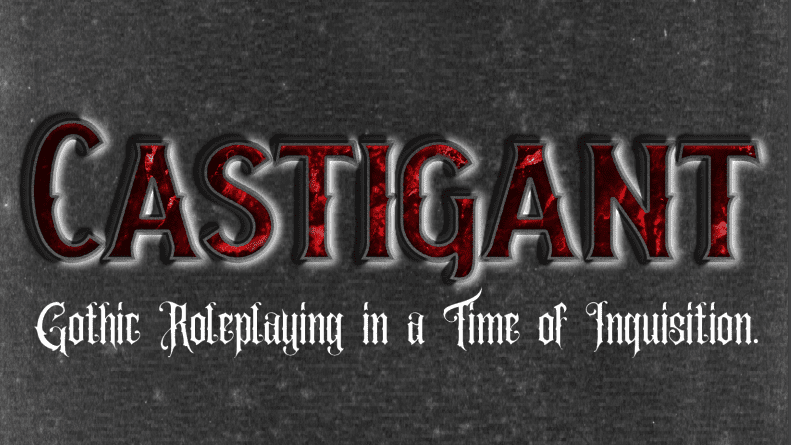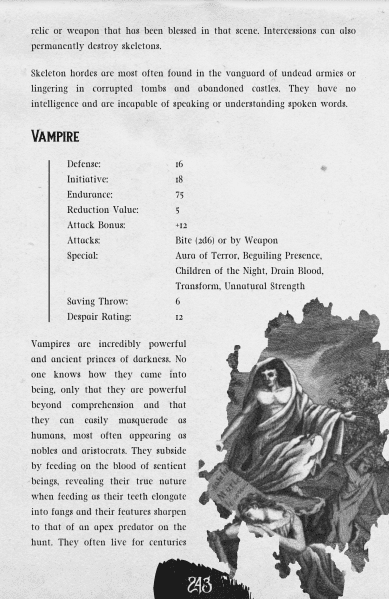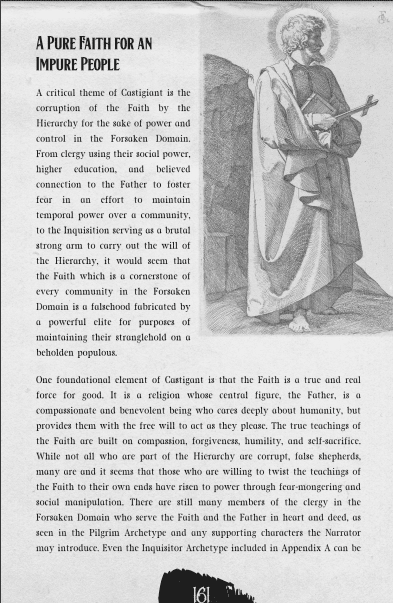
Once again we find ourselves in the month of October where the weather gets colder, I become one year older, and our communities are infested with spooky scary skeletons. Last year I reviewed the 5th edition of Dungeons & Dragons and in that review I expressed interest in reviewing some of the D&D alternatives that exist in the tabletop roleplaying genre. One year later I haven’t exactly made good on that promise, but in the spirit of October I have just the game for the occasion.
Castigant: Gothic Roleplaying in a Time of Inquisition was created by James M. Spahn and released on Drive-Thru RPG in 2022. While horror is a genre I typically tend to avoid, I’ll occasionally dabble in classic books such as Mary Shelly’s Frankenstein and video games like Castlevania. What possessed me to try a game like Castigant? Well gothic horror at its best can actually be rather hopeful despite the darkness it explores or at the very least impart a good moral message. Additionally, Spahn is Catholic so I trust him to avoid going full grimdark and wasting my time.
The book starts with character creation in which players determine the attributes, background, and archetype of their characters. Attributes are a set of 6 numbers representing Might, Finesse, Resolve, Insight, Bearing, and Weal. These numbers are determined randomly by rolling 3 six-sided dice and adding the results together for each attribute. It’s a fairly standard method of establishing what a given character is naturally capable of and it works about as well here as anywhere else.
Then there’s the first stage of crafting a character’s background and one of Castigant’s defining features, Sorrow. Sorrows are traumatic events that haunt a player character for one reason or another. Everytime something happens that reminds a character of one of their Sorrows they must roll the dice to see if they find the resolve to face their fear or falter under its weight, both outcomes will lead to consequences for other rolls. Each character starts with one Sorrow and will gain more naturally through the events of the game. If a character overcomes a Sorrow 5 times that Sorrow is lost and the character makes progress towards leveling up and becoming stronger.

Mechanically speaking, Sorrows push the game towards a heavy focus on storytelling over traditional dungeon crawling. Personally I think it goes a little overboard being the only method of leveling up, especially since overcoming Sorrow comes down to a literal dice roll. This creates a scenario where the game is forced to revolve around the player characters’ Sorrows at the expense of everything else. For example if the gamemaster has an unlucky player who consistently fails his Sorrow rolls and falls 2 or 3 levels behind the other players, the gamemaster will have to sacrifice the game’s variety to ensure that player has more chances to make Sorrow rolls and catch up. So if our unlucky player has a sorrow related to encounters with zombies and the gamemaster starts adding a suspiciously large amount of zombies to the game, the group’s immersion will start to break as everyone at the table can see the man behind the curtain pulling the strings.
Moving on, the next stage of character creation involves players rolling dice for their social class and profession. Social class primarily determines the character’s starting resources, items, and literacy. Professions are subdivisions of each social class that grant additional bonuses including items, abilities, skills, or even attribute points. I enjoy this randomized approach to backgrounds as it helps emphasize the nature of player characters as a ragtag band of misfits which the game was clearly built around. Additionally, it ensures players can’t abuse the system by conspiring to all come from aristocratic professions and pool together a massive stockpile of resources at level 1.
Choosing an archetype is the final step when creating a character and arguably the most significant of any choice. The 5 main archetypes include Metaphysician, Pilgrim, Reliquary, Scapegrace, and Soul-Bound with 2 advanced archetypes (Dhampir and Inquisitor) offered in the optional rules index. Each one comes prepackaged with a set of abilities that defines their role within a group. For example the Reliquary is a combat oriented archetype bound to a fully customizable “Relic Weapon” perfect for slaying monsters (and a great way for Castlevania fans to recreate their favorite Belmonts). Character creation shouldn’t be too hard for anyone familiar with roleplaying games. Unfortunately there is a lot of flipping back and forth through the book to get information on things like armor, weapons, items, incantations, and intercessions in later chapters, but every tabletop game suffers from this problem to an extent.
The following chapters detail the nitty gritty of the mechanics surrounding items, exploration, combat, and other useful tools at players disposal. For the sake of time I won’t go over everything as good chunks of it follow standard roleplaying conventions, but I will touch on the things I think make Castigant different. First however, I’d like to address something I feel very strongly about in roleplaying games, the threat of death. In many modern roleplaying games, such as 5th Edition Dungeons & Dragons, the threshold of death is often so obscured by safeguards that it is practically nonexistent. Castigant is a far more brutal game by comparison through its implementation of a grievous wounds table which the players roll on when their characters lose all of their endurance points. If the players are extraordinarily lucky they might get off without any long term consequences, but it is far more likely that they will receive crippling injuries that impose permanent mechanical disadvantages moving forward assuming they don’t die outright then and there which is also a possibility.
Needless to say I was very happy with Castigant’s handling of death. It also ties in nicely with my next topic: despair. Despair is something of an extension of the ideas of Sorrow, being a dice roll that occurs whenever the players witness a horrific evil. If a player fails their despair roll they will suffer disadvantage while attacking or making additional saving throws. Despair can occur basically wherever the gamemaster deems it appropriate, but it will always occur at either the death of another player character or when first encountering a powerful supernatural creature. The last scenario is particularly important because monsters have a despair rating that is measured against the player character’s level. If a character manages to survive long enough they might develop the fortitude to stare down monsters like Werewolves and Succubi, but even the strongest characters might break when up against a Vampire or Demon Prince. This is a great way to express how far a character has come of the course of a long campaign, but also maintains the horror element at all levels of play.

Another set of mechanics worth mentioning are the Incantations and Intercessions which are essentially this game’s version of spellcasting, but such a description really sells it short upon closer inspection. Incantations are the dark arts wielded by the Soul-Bound archetype, invoking the destructive power of the seven deadly sins. When using an Incantation the player rolls on a table to determine its effect. On high rolls Incantations impose massive hindrances and/or damage on enemies while on low rolls the Incantation backfires on the user and they are consumed by the sin they sought to weaponize. For example, if the user invokes the Sin of Pride they can restrict their enemy’s movement with supernatural frost (referencing the 9th circle of hell in Dante’s Inferno), but in doing so they run the risk of becoming unable to sympathize with others or reconcile with their own sorrows. The risky nature of Incantations mechanically is a fantastic representation of the dangers of sin through gameplay, a quick and easy path to power that ultimately leads to self-destruction.
All that being said, if you thought Incantations were a thematically appropriate mechanic sit down, strap in, and let me tell you about Intercessions. Intercessions are divine prayers available to the Pilgrim archetype used to receive miraculous boons. Unlike Incantations which can be invoked more or less whenever the user wants, Intercessions require the character to meet several conditions before they can be used. The conditions are: 1. Spend a half-hour every day in devout prayer. 2. Carry a holy symbol or other onward sign of the faith. 3. Never deny belief in, or teachings of, the Father. 4. Speak in defense of the Faith against anyone who publicly opposes it. 5. Never knowingly endanger the innocent or pious. 6. Never amass more material wealth than necessary to survive or fulfill one’s duties. 7. Never deny aid to the innocent or pious when in a position to help. Should the user ever break these conditions, they will lose their ability to use Intercessions and will need to make a confession and complete a penance to regain the ability.
On top of everything else, Intercessions are rolled with disadvantage unless the user has met a Holy Obligation related to the Intercessor they intend to ask for help. For example if a player character seeks the Intercession of The Maiden Crusader (the Intercessor based on St. Joan of Arc) they must spend four hours each week giving self-defense lessons to civilians of the Common or Wretched social classes. The benefits of an Intercession also correlate to the chosen Intercessor and include things like recovering endurance, receiving bonuses to attack rolls, and so on and so forth. If the user rolls poorly on the Intercession tables however, they are found wanting by the Intercessor and incur some sort of penalty until they perform a relevant penance.
Intercessions are the most genius integration of Catholic teachings and values I have seen in any game I have ever played. An airtight set of conditions that encourages players to roleplay their characters with authenticity to the Christian way of life and the use of Saints as intercessors to bring the character’s prayers before God who in turn blesses them with divine assistance is a borderline mechanical masterpiece. I do however have some reservations about the fact that failing an Intercession roll results in a penalty which doesn’t make much sense theologically and only seems to exist as a way of balancing the mechanic next to the Incantations. But the cherry on top of this brilliant mechanic are Lesser Prayers which grant small bonuses once per day for any character of any archetype so long as they meet a shorter, but similar list of roleplaying requirements. This gives non-Pilgrims a chance to be rewarded for pious roleplaying, reflecting the fact that Sainthood is possible for everyone and not just priests, monks, or nuns.

The last feature of note in Castigant I wish to discuss before wrapping things up is its prescribed setting and the Inquisition mechanics. Castigant takes place in a loosely defined setting referred to as The Forsaken Domain which is meant to facilitate as many gothic horror genre conventions as possible. The book won’t tell you the names of the land’s ruling aristocracy or the description and location of a particular town, but it will give you all the tools you need to do it yourself. Some of the game’s base assumptions include a time period somewhere between the late 17th and early 19th century, a dark land where monsters lurk in dreadful places, a group of nomadic player characters who heroically choose to fight against the evils plaguing the land, and a local population gripped so tightly by fear and paranoia that most of their sovereignty has been handed over to an Inquisition which subsequently has also become very corrupt.
These details are important for mechanics related to the various communities the players come across be it a hamlet, town, or city. Every community has an Inquisition rating which determines how likely outsiders such as player characters are going to become targets of the Inquisition. The community’s Inquisition rating will increase depending on what the player characters do. Some are pretty obvious like engaging in criminal behavior, but other offenses include inquiring or revealing any dark secrets held by prominent members of the community or visiting a place within or nearby the community they consider to be haunted or cursed. If the players fail any Inquisition rolls they will become the target of the community’s fury and be arrested to be tried as heretics, if not executed or chased out of town. It’s not all doom and gloom however, as doing good deeds for the community will lower the Inquisition rating with the possibility of player characters fully integrating into the community if they choose to pursue such an honor.
The community and Inquisition mechanics are a great way of adding tension to places players otherwise might feel safe and secure. Castigant is a horror game after all, so anything that creates suspense can only add to the game’s atmospheric qualities. Though I will say that I have mixed feelings about the choice of Inquisitors as the corrupt, tyrannical overlords of the Forsaken Domain. On one hand the fallen clergyman who is just as guilty of the evil he claims to condemn is a common trope in gothic horror literature so in the spirit of the genre I can’t exactly fault the game for including it. And to be clear, the book itself does not assume the Church is irredeemably corrupt from top to bottom, it just assumes that within the Forsaken Domain corruption is particularly rampant. Historically however, the stereotype of the Inquisition, especially the Spanish Inquisition, as a uniquely cruel invention of the Catholic Church that killed countless innocent people is a bold-faced lie perpetuated by those with a vested interest in destroying the Church and its legacy.
Thanks to archives of the Spanish Inquisition we know that they were a very methodical organization that went to great lengths to ensure all accused were given a safe and fair trial with the ultimate goal of rehabilitation, not execution. In fact if you add up every inquisition from every country during the institution’s 300 year tenure the number of executions was about 10,000 to 30,000 people at most. To put that number in perspective, during the French Revolution just as many Christians would be executed in a single month in the name of state-sponsored atheism. This is not to say the Inquisition never did anything wrong, quite frankly any organization run by humans will always fall into some sort of scandal at some point no matter how well intentioned, but the image of the Inquisitor as a hypocritical monster has lingered on for far too long and as Catholics we should feel no shame in calling our enemy’s bluff when they attempt to weaponize it against us.

Outside of Castigant’s gaming content there is also the matter of the book’s presentation. Visually the book makes use of blotchy stains, famous quotes from gothic literature, and period appropriate paintings from the public domain that give it a little extra charm despite clearly being made on a low budget. The text itself however, to put it bluntly, is rather sloppy with spelling mistakes, formatting errors, and poorly masked copy-pasting. Fortunately there’s only one or two instances where these problems cause serious confusion so hopefully these issues will be resolved by a second printing or revised edition in the future.
Castigant: Gothic Roleplaying in a Time of Inquisition is unique among tabletop roleplaying games to say the least. I certainly have my criticisms and nitpicks here and there, but overall I think it’s among the best TTRPGs out there if you’re looking for a good horror themed game. Synthesizing tried and true D&D mechanics with thematically poignant elements of gothic literature make Castigant something special that I hope to use at my table for years to come. Until next time I wish you all a happy spooky month.
Score: 75%
Gameplay: 4/5
Visuals: 3/5
Writing: 3/5
Replayability: 5/5
Morality & Parental Warnings: Castigant: Gothic Roleplaying in a Time of Inquisition is a tabletop roleplaying game, meaning the contents of the game will vary depending on the players involved since the game largely takes place in the group’s imagination. That being said the game is horror themed so most games will probably involve monsters like vampires, zombies, werewolves, sorcerers, demons, ghosts, and other abominations. The game also assumes some amount of combat using various weapons and supernatural powers will be involved as well, but it is only as graphic as one’s imagination. The book provides sample plot hooks and dark secrets for the game master’s convenience, most of which tackle intense or unsettling subject matters like corruption or murder.
